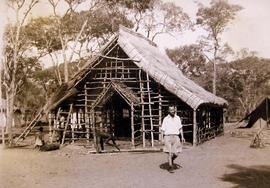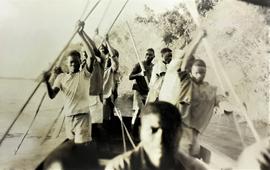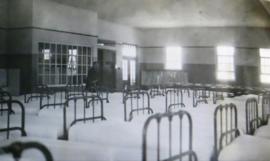Papers of the Irish Capuchin Missions in Africa
- IE CA AMI
- Subfonds
- 1903-2018
Part of Irish Capuchin Archives
The Capuchin Franciscans have worked in Ireland since the seventeenth century. From the middle of the nineteenth century the Irish Capuchins manifested a missionary zeal which took them from home to the furthest corners of the globe. Irish friars have undertaken overseas missions in the United States, Africa, New Zealand, and South Korea. Well over one hundred Irish Capuchins have ministered in Africa since the first friar arrived in South Africa in 1929, and in Zambia (formerly Northern Rhodesia) in 1931.
South Africa
In 1927 the Vicar Apostolic of Cape Province in South Africa, the Most Rev. Bernard O’Riley (1868-1956), invited the Irish Capuchins to open a mission. The friars responded positively to this request and in 1929 Fr. Casimir Butler OFM Cap. (1876-1958), Fr. Alban Cullen OFM Cap. (1902-1957) and Fr. Declan McFadden OFM Cap. (1901-1979) began missionary work in the Cape Flats on the outskirts of Cape Town. From the outset, the friars ministered among the marginalized black and ‘coloured’ (or mixed-race) populations of the area. Two foundational parishes were initially assigned to the Capuchins at Athlone (St. Mary of the Angels) and at Parow (Immaculate Conception). Parow is located eleven miles from the centre of Cape Town. The parish included the townships of Elsies River and Vasco located in the greater Cape Town municipality. The racial composition of Parow was mixed with both white and ‘coloured’ inhabitants. Athlone is located six miles from Parow and about twelve miles from Cape Town and has a predominately mixed-race population. In 1935 the Athlone foundation expanded to incorporate ministries at other locations including Langa and the Welcome Estate. Additional ministries were commenced in Matroosfontein (1933), Tiger Valley (1951), Belgravia (1954), Bridgetown (1967) and Elsies River (1979). All these parishes are situated in the Archdiocese of Cape Town. Within five years of arriving in South Africa, the Capuchins had built churches at Athlone and at Parow. Presbyteries, schools, and training colleges followed.
Of necessity, the Capuchins in Cape Town worked chiefly as parish priests offering public masses, attending sick calls, and promoting the cause of temperance. Other duties included evangelisation, organising lay religious sodalities, ministry to coverts, pre-nuptial courses, retreats, prison ministry, and promoting vocations and formation work for new friars. Despite the violent political unrest provoked by the system of racial discrimination known as apartheid, the Irish friars continued to labour among the poorest and most segregated in South African society. The work of the Capuchins with the ‘coloured’ population of Cape Flats and in the townships continued despite the frequent and fierce repression of the white minority government. In the seven parishes served by the Capuchins in South Africa in the 1980s, five were in the so-called ‘coloured’ areas, one in the African area, and one which straddled a racially mixed district. Education was a key element of missionary work within the Capuchin parishes and schools were established with the assistance of the Holy Cross Sisters, the Christian Brothers, and other religious congregations. The Capuchin Custody of South Africa remains under the jurisdiction of the Irish Capuchin Province and Irish friars continue to work in a variety of religious and social ministries in the country alongside missionary friars from Tanzania and India.
Zambia
In 1930 another field of missionary activity was offered to the Irish Capuchins. They were invited into vast area of 168,000 km2, comprising the Livingstone district and Barotseland, the western province of what was then called Northern Rhodesia (now the Republic of Zambia). Before 1931 there was no resident priest in the whole area from Livingstone to the Angolan border in the north. Prior to the arrival of the Irish Capuchins in 1931, the Barotseland mission was nominally under the control of the Prefect Apostolic of Broken Hill (now Kabwe), a town nearly four hundred miles north of Livingstone. The territory was effectively virgin-soil for Catholic missionary work. The only previous attempt at evangelization in Barotseland was unsuccessful. In 1881, the Jesuits had entered the territory and received permission from the local Paramount Chief but the presence of the Protestant missionary association, the Paris Evangelical Missionary Society ('Société des missions évangéliques de Paris'), disrupted their work in the district.
In 1931 three Irish Capuchins arrived in Livingstone with the intention of opening a new mission. Fr. Casimir Butler OFM Cap. set about constructing a friary in Livingstone. Fr. Declan McFadden OFM Cap. and Fr. Killian Flynn OFM Cap. (1905-1972) arrived in October 1931, with Fr. Timothy Phelim O’Shea OFM Cap. (1902-1979) and Fr. Seraphin Nesdale OFM Cap. coming in February 1932. Soon afterwards, the Capuchins began exploring the interior of Barotseland establishing a centre at Loanja, about one hundred and fifty kilometres north of Livingstone. The missionaries encountered many difficulties. There were no roads, and the friars travelled on foot or in canoes and on barges on the Zambezi River. Lions, leopards, and crocodiles posed some threat but more harmful to health were the smaller creatures such as tsetse flies and mosquitoes which carried a significant risk of malaria and other diseases. The friars also had to acquire knowledge of the local language of Lozi. Within two months of arriving at Loanja in 1932, the friars had built houses for themselves and their workers as well as a church and a school. These were simple structures with the walls supported by poles set into the ground interwoven with wattles and plastered with mud. The roofs were thatched. However, Loanja proved to be less than an ideal location as it was situated in a desert area and with a widely dispersed and small population. In 1936 the friars moved to Sichili. In the meantime, the friars worked diligently on acquiring an understanding of the local language and customs. The catechism was translated and printed in 1933 and this was followed by a translation of the New Testament. The influence of the Protestant missionary groups in the area continued to be a serious impediment as they laid to claim to vast swathes of the territory as their ‘sphere of influence’ to the definite exclusion of Catholic missionaries. Despite these difficulties, the Irish friars succeeded in opening a new mission station at Lukulu in December 1935.
In May 1936 Fr. Killian Flynn OFM Cap. was appointed the first Prefect Apostolic of Victoria Falls. Under his guidance, the provision of education and medical services became spearheads of mission development as new stations were opened at Mankoya (1938), Sihole (1943) and Katima Mulilo (1944) located in the Caprivi Strip in what was then South West Africa (now Namibia), and later at Malengwa (1947). A total of twenty-one Capuchin missions were established throughout Barotseland. Each friary, besides being a residence for the missionaries, acted as a base for outreach for evangelization and development in the surrounding districts. In March 1950 the Prefecture was raised to be the Vicariate Apostolic of Livingstone with Fr. Timothy Phelim O’Shea OFM Cap. consecrated as Vicar Apostolic in September 1950. In August 1959 the mission territory of the Vicariate of Livingstone was erected into the Diocese of Livingstone and the Most Rev. Timothy Phelim O’Shea OFM Cap. was installed as Bishop. He remained Bishop of Livingstone until the nomination of Monsignor Adrian Mung’andu (c.1920-2007) in 1974.
Additional mission stations were opened throughout the 1960s. Churches were built in each Boma or administrative centre, in Nalionwa (1960), Senanga (1966), Mongu (1966), Sesheke (1967) and at St. Conrad’s Friary in the capital, Lusaka. At this time the decolonization of Africa was continuing apace, and Zambia achieved independence from British rule in October 1964. Support for the Irish missionaries came in 1965 with the arrival of American friars from the New Jersey Capuchin Province. They were allocated the northern section of the Livingstone Diocese and they opened a new mission station at Kambompo (1966). This built upon the work of other religious congregations primarily in the fields of education and health care. The Holy Cross Sisters had worked in the country since 1936. This congregation was founded by a Swiss Capuchin priest, and the sisters devoted themselves to teaching and to the care of the sick (especially leprosy victims). An orphanage was opened in Sichili and later the sisters established secondary schools in Lukulu and in Malengwa. An emphasis was placed on the education of women and a female teacher-training college was also opened by the Holy Cross Sisters. The Franciscan Missionaries of the Divine Motherhood arrived in 1946 and established a hospital in Kasaba. From the late 1940s, they worked alongside the Irish friars in running hospitals in Mangango, Sesheke and Chinyingi. In 1967 the Irish Christian Brothers took over the running of secondary schools in Katongo and in Livingstone. Many lay people (from Ireland and elsewhere) came to Zambia to work as teachers, nurses, doctors and development workers at the Capuchin mission stations.
The rapid progress in the building of schools, hospitals and health-care centres in these years was remarkable, since the colonial government had made little or no provision for such services. These developments were largely due to the generous financial support offered by the Capuchins in Europe and in North America and through public fund-raising efforts of Capuchin mission offices and lay associations. In 1974, a total of two hundred and twenty primary schools were handed over by the Diocese of Livingstone to the government, which hereafter had responsibility for their administration. The provision of assistance to Angolan refugees became a major focus of the work of the Irish Capuchins in Zambia in the 1980s. Fr. Benignus Buckley OFM Cap. was the principal co-ordinator at the Sioma mission dealing with the huge numbers of refugees fleeing the civil war in Angola who were accommodated in various camps in Namibia and in Zambia. While there was an emphasis on education and health care services in the Zambian mission, the friars also strove to promote their own Capuchin way-of-life. A major weakness was identified in the lack of local vocations. Ad-hoc efforts were made to promote vocations and develop a novitiate programme before the establishment in 1983 of the Franciscan House of Studies just outside Lusaka to provide training for men aspiring to become friars. In 1992 the Franciscan House of Studies became St. Bonaventure’s College, a formation centre for the Franciscan Orders. In July 2007 a dedicated Capuchin novitiate was opened at Camerino near Lusaka.
Over one hundred Irish friars and nearly twenty American Capuchins have ministered in Zambia since the start of missionary work in the country. The numbers peaked in the late 1960s when there were sixty-two missionary friars in the country. Today, in the territory originally assigned to the Irish Capuchins, eighteen different religious congregations have a presence. There are approximately thirty-one parishes with various apostolic groups responding to the many spiritual and social needs of the local populace. Working alongside members of other religious congregations and lay professionals, the friars have had an immeasurable impact on the lives of many impoverished Zambians. The Capuchin Custody of Zambia remains under the jurisdiction of the Irish Capuchin Province. Irish friars are still working and ministering in Zambian continuing an unbroken ninety-year record of service on the continent.
Collection Content
The African mission collection in the Irish Capuchin Archives includes correspondence, visitation records, financial reports, diaries and journals, oral histories, publications, newspaper clippings and photographs (in albums, loose files and born-digital format) relating to the many years of Irish Capuchin missionary activity on the African continent. The collection comprises material sent back to the Irish Province and to the Capuchin Foreign Mission Office by Irish Capuchins in Africa from the 1930s onward. The papers chronicle the life and work of the Irish Capuchins since their arrival in South Africa in 1929 and in what was then known as Northern Rhodesia (later Zambia) in 1931. The files of correspondence between the missionary friars and their Provincial Ministers in Ireland illustrate the areas or spheres in which they laboured: parish work, education, health-care, social development and evangelization. Geographically, this work took place primarily in Cape Town, South Africa, and in Barotseland, later the western province of Zambia. The records reflect the impact of the Irish Capuchin missionary presence particularly in the building and management of parishes, and in the fields of education, health-care provision, and socio-economic development.



